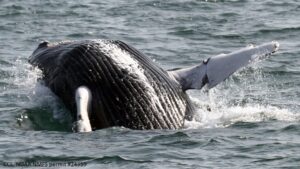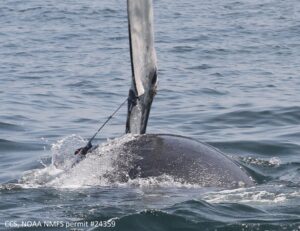PROVINCETOWN — Cape Codders have become acutely aware that whales in the Gulf of Maine face perilous struggles with ocean debris, especially discarded rope that obstructs their paths and entangles their bodies.
Scott Landry, director of the Center for Coastal Studies Marine Animal Entanglement Response Program, is working on an unusual and highly complex whale entanglement case: a humpback calf with monofilament fishing line tightly wrapped around its left flipper, threatening to amputate it.
The CCS team, together with the marine mammal rescue team from the International Fund for Animal Welfare (IFAW), have collaborated on an effort to sedate the young whale in hopes of making a close approach to free it possible. So far, they have not succeeded.

“The team is now regrouping,” said Dr. Sarah Sharp, the marine mammal veterinarian at IFAW who has led two attempts to sedate the whale, the last one on July 26.
This is the first time a sedative has been used in a whale disentanglement case since 2011. “Whales are conscious breathers,” said David Matilla, coordinator of the Global Whale Entanglement Response network at CCS. Oversedation — putting the whale to sleep — could lead to drowning, he said. Matilla was part of the first response unit to use a sedative to disentangle a whale in 2001.
“This is a case unlike any we’ve encountered before,” said Landry, who has been disentangling whales since 1998. “So far, the whale doesn’t show any sign of infection,” he said, “probably because it’s still nursing, and its immune system is bolstered,” he added.
Landry first became aware of the entangled calf in the Stellwagen Bank Marine Sanctuary on June 26. The calf was the subject of an essay by columnist Dennis Minsky in the July 12 issue of the Independent.
“Whales are getting entangled all the time,” Landry said. “Most of the time, they can get themselves out of their entanglements.” Landry’s team intervenes in cases where the whales cannot free themselves, he said.
According to CCS data, more than half of the humpback whales in the Gulf of Maine exhibit scarring from prior entanglements, and an average of 12 percent of the population becomes entangled annually.
Challenges of Monofilament
Monofilament — the type of fishing line involved in this case — is a clear nylon-based material consisting of strong, very thin fibers. It is practically invisible in the water, and it easily slices whale blubber, Landry said.

Dealing with monofilament entanglements, as opposed to rope entanglements, presents particular challenges for the rescue team. In rope entanglements, the team uses grappling hooks and buoys to slow the whale down before safely cutting away the rope. Landry said employing the same strategy with monofilament increases the risk of fatal injuries.
“Trying to remove it means approaching the whale from our boat, getting within point-blank range of it, and trying to get a knife at the end of a long pole down through the water onto that line wrapped around its flipper,” said Landry.
Landry said the CCS rescue boat, Ibis, is 35 feet long and requires flat seas for the team to stand and move around to help free the whale safely. Despite their large size, whales are difficult to find, Landry said. His team has “headed out on the water seven times to go to the calf and found it on only three occasions.
“The whale can sometimes disentangle itself from the monofilament gear,” Landry said, if the hook on the end of the monofilament line rusts, causing the wire to fall away. Consequently, the rescue team is cautious in cases that are not life-threatening, avoiding interventions that might pull on the wire and potentially cause further harm to the distressed whale.
But in this case, as the monofilament’s tight grip threatens to amputate this calf’s flipper, waiting is not a viable option. “We believe at this point the wire has reached the bones in the flipper, and that has stopped its progression,” said Sharp. “But eventually, it will start cutting into those bones as well.”
The calf’s unpredictable movements are what made it difficult to administer sedative doses successfully, Sharp said. The sedative darts the team has fired have so far either only partially discharged or have hit the calf but failed to slow it enough to allow rescuers to come alongside and cut away the wire.
Tuna Fishing Connection
Landry said monofilament entanglements are a local phenomenon. “The number of cases reported of whales entangled in hook and line monofilament is exceptionally high in this area due to tuna fishing,” he said.
In the scheme of things, said Charles “Stormy” Mayo, senior scientist and chair of the Dept. of Ecology at the Center for Coastal Studies, rope is a bigger problem for whales than monofilament. But a monofilament entanglement like this one can happen because the humpback whales that are here in the summer often feed on the same fish as the tuna.
“You don’t know how this happened,” said Mayo. “But it would be unlikely for a whale to be entangled in a bundle of line spooled off and tossed away.” He said it is “more likely that the whales are being hung up in line that is being fished.
“Dropping bait for tuna where the humpbacks are,” he said, increases the likelihood of entanglement.
Tammy Silva, a research scientist at the Stellwagen Bank Marine Sanctuary, explained how this calf’s flipper may have become ensnared. “When whales hit the gear, they’ll panic, and sometimes start to roll,” she said. “When they roll, that’s when the gear can become wrapped around their body or specific parts like the fluke or the flippers.”
Of the 14 whale entanglements Landry’s team has addressed this year, four were from monofilament and the other 10 were rope-based. Landry said most monofilament entanglements are likely not reported. CCS data indicate that fewer than 10 percent of the whales that suffer new entanglement injuries are seen and reported while entangled.
Landry called on fishermen to avoid areas where whales are present. “If whales move into an area where you are fishing with hook and line, if you leave the area then you won’t entangle the whales,” he said.
Collective responsibility is required to reduce entanglements, said Landry. “Everyone involved, from consumers of our fishing community’s catch to regulators mandated to protect whales, must be part of the conversation,” he said.



